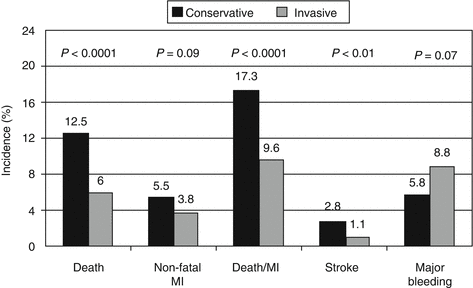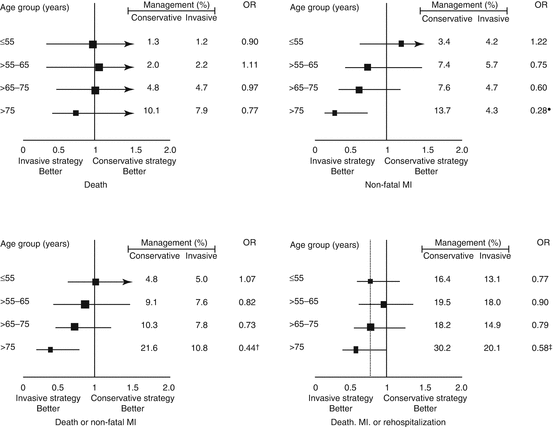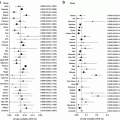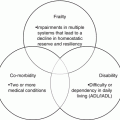Fig. 6.1
Organization of STEMI patients, describing pre- and in-hospital management and reperfusion strategies. Care should be given to anticoagulative therapies, but also individual therapy disposals are of high importance. Despite a higher bleeding rate with anticoagulation and especially fibrinolysis, no different treatment in elderly patients is warranted DI-DO door-in to door-out time, DTB door-to-balloon time, EMS emergency medical service, FMC first medical contact, FMCTB first-medical-contact-to-balloon time, PCI percutaneous coronary intervention, STEMI ST-segment elevation myocardial infarction (Adapted from Windecker et al. with permission. (see Ref. [9]))
Nevertheless, with increasing age the incidence of STEMI-ACS decreases, and to some extent more patients present with NSTEMI-ACS (non ST-elevation myocardial infarction). In NSTEMI-ACS the situation appears to be more complex. Patients often have multiple comorbidities and diffuse coronary artery disease without the possibility to identify a culprit lesion. The higher complication rate for elderly patients treated interventionally additionally impedes the decision to perform intervention in NSTEMI-ACS. Specific patients are often denied interventional treatment, while other patients with a possibly higher risk for complications, receive an invasive treatment. Although strong evidence [10] exists that high risk subsets, i.e. elderly patients, may actually gain most from an intervention, there is an obvious lack of evidence, since patients >75 years comprise only 9 % of clinical trial population and only about 50 % of registry patients [9]. In the past, presumably due to the fear of complications and in combination with an ambiguity concerning the success of an intervention, decisions resulted in a reluctance to perform invasive procedures in elderly patients.
Despite all advances and increasing evidence, treatment decisions in elderly patients with NSTEMI are characterized by a continuing uncertainty about the following:
the adequate type and
the adequate time of treatment (for those patients who are considered for invasive treatment; e.g. interventional versus conservative with optimal medical therapy, need for pre-interventional preparation [recompensation, hydration, respiratory stabilization])
the adequate risk assessment to identify patients who will benefit from an intervention and those, who will not
the adequate outcome measurement of any treatment in elderly patients (mortality and MI versus improvement in functional capacity).
Data
There is limited randomized trial data available to guide treatment in elderly patients with acute coronary syndromes. In a recent large German multicenter registry, substantial age related differences were identified in the diagnosis and treatment of elderly patients presenting to a hospital with acute myocardial infarction. The results confirmed, that elderly patients are a significant and increasing proportion of the total population treated for ACS [11–13]. The proportion of 28.1 % elderly patients in the more recent ALKK registry data of 2008 is 2.4 % higher than the numbers enrolled in the older “Global Registry of Acute Coronary Events” (GRACE)–registry, which included 24,165 patients with a rate of 25.7 % subjects aged >75 years, possibly suggesting an increase over time [11].
In a prior published registry of patients with NSTEMI-ACS, over 35 % of the population were >75 years, emphasizing the growing importance to examine outcomes in the older age group [14]. In contrast to a significant difference in treatment modalities between elderly and younger patients (invasive strategy 39 % vs. 56 % with a 30-day mortality nearly fourfold higher in the elderly population) the study identified, that age-related differences in diagnostics or the percentage of patients who were treated with PCI in comparison to the younger patient cohort, were much less pronounced. Therefore, the more recent data showed a trend towards a stronger adherence to evidence based medicine with increased utilization of resources in elderly patients albeit the recommendations were primarily based on younger cohorts.
As outlined before, older patients with suspected acute myocardial infarction (MI) often present to the emergency department (ED) with atypical symptoms and inconclusive electrocardiograms (ECG). The use of cardiac Troponin (cTn) has considerably improved risk assessment and diagnostic accuracy in the ED. The diagnosis of MI has been further improved by the introduction of novel high-sensitivity cTn assays. Their analytical precision can lower the cTn cut-off point, according to current definition of acute MI (cut-off defined as the 99 % confidence interval of a healthy reference population). These assays can measure low-level myocardial injury, which are not detectable by standard cTn assays. However, Bahrmann et al. showed that the introduction of high-sensitivity cTn assays substantially increases sensitivity to identify older patients with ACS, even at the time of presentation to the emergency department at the cost of specificity. Subsequently, the prevalence of elevated cTn has more than doubled with the use of high-sensitivity cTn in older patients. No coronary cause was found in two-thirds of older patients, although more non-ST-elevation myocardial infarction (NSTEMI) patients were diagnosed earlier by high-sensitivity cTn [15]. Therefore, the emergency physician encounters increasing difficulties to identify those patients who are in need for invasive diagnostics [16]. In this setting, the use of an additional marker, for instance copeptin, may be helpful for diagnostic work-up. Copeptin is the stable signal peptide of the vasopressin precursor and is considered as a non-specific marker of stress. Bahrmann et al. showed that the diagnostic improvement of copeptin in addition to high-sensitivity cTn is moderate, but it may help to reliably rule out NSTEMI in unselected older patients presenting to the ED [17]. In older patients serial high-sensitivity cTn measurements and absolute delta-changes at 3 h were more valuable for early diagnosis of NSTEMI [18].
On the basis of evidence from randomized trials, which were predominately performed in younger patients, guidelines recommend early interventional treatment for high-risk patients in the presence of ACS [9]. In recent years increasing evidence has suggested, that patients at risk, including elderly patients, gain most from invasive procedures in the presence of ACS [10, 11, 19]. The extent to which this evidence has had an impact on real world management of elderly patients with ACS remains unclear. Elderly patients with ACS, a high risk population itself, often do not undergo interventional treatment as recommended by current guidelines [11, 20] Table 6.1.
Table 6.1
Criteria for patients at high risk with urgent indication for an invasive management
Primary criteria |
1. Relevant rise or fall in troponin |
2. Dynamic ST- or T-wave changes (symptomatic or silent) |
3. GRACE score >140 |
Secondary criteria |
4. Diabetes mellitus |
5. Renal insufficiency (eGFR <60 mL/min/1.73 m2) |
6. Reduced LV function (ejection fraction <40 %) |
7. Early post-infarction angina |
8. Recent PCI |
9. Prior CABG |
10. Intermediate to high GRACE risk score (http://www.gracescore.org) |
In a study, evaluating treatment decisions in elderly patients with NSTEMI-ACS Rittger et al. found, that age itself was the most powerful predictor of conservative treatment in a population of elderly patients presenting with ACS to the hospital [21]. This finding was very much in accordance with previous reports. In a registry of patients with NSTEMI a significant difference was found in the treatment modalities between elderly and younger patients (invasive approach 39 % vs. 56 %) and outcome with a 30-day mortality was nearly 4-fold higher in the elderly patients [14]. Comparably, in the GRACE registry, in which elderly (n = 4776; 19.8 %) and very elderly (n = 1427; 5.9 %) were diagnosed with coronary angiography in only 55 % of the cases and 33 % respectively, while 67 % of the younger patient population received coronary angiography [11].
In the previous mentioned report of Rittger et al., the second most important factors to influence decision making, were Killip Class III and the presence of multivessel disease. The reluctance in forwarding patients with Killip Class III to an invasive/interventional treatment might be explained by the apprehension towards mechanical ventilation combined with a prolonged stay in the intensive care unit. Both potential consequences of the deterioration of the respiratory situation due to the use of contrast agents and a prolonged intervention time. This is emphasized by the fact, that patients with Killip Class II were more likely to be treated interventionally and that the presence of Killip Class IV (patients in cardiogenic shock) had no significant impact on the treatment strategy.
Impending renal failure explains adequately, why an interventional approach is delayed or withheld. Nevertheless, in a recent analysis, Morici et al. could identify, by evaluating the association between baseline creatinine clearance (CrCl), coronary revascularization during index admission and 1-year mortality in elderly patients with an acute coronary syndrome (ACS), that coronary revascularization decreases the risk of 1-year death across each CrCl category and is one of the most powerful predictors of 1-year outcome. The authors stratified 313 patients aged ≥75 into four groups, according to CrCl on admission (using a cutoff of 45 ml/min) and coronary revascularization versus medical management. The mean age of the study population was 81 years and the median serum creatinine level on admission was 1.0 mg/dl (interquartile range (IQR) 0.8–1.3). Patients with impaired renal function treated medically had a higher in-hospital and 1-year mortality rate, especially if compared with patients with preserved renal function undergoing revascularization (1-year mortality 22.9 % versus 4.9 %). Across the spectrum of CrCl categories, coronary revascularization was independently associated with a lower risk of mortality (HR 0.405; 95 % CI 0.174–0.940; p = 0.035). The authors concluded, that coronary revascularization decreases the risk of 1-year mortality across each CrCl category and is one of the most powerful predictors of 1-year outcome [22].
Patient selection appears to be the most crucial point – choosing patients in an elderly population who will benefit most from coronary intervention. Conditions like the presence of a prior stroke or obesity, the fear of intracranial hemorrhage or access site complications, may deter the responsible physician to forward these patients to coronary angiography and PCI. The type of myocardial infarction (NSTEMI or STEMI) or the presence of prior AMI, as well as the presence of supraventricular arrhythmias has less, but still significant, influence on the treatment strategy. It is comprehensible, that an acute invasive intervention is denied to elderly patients presenting with tachyarrhythmic atrial fibrillation. However, according to current data, the presence of prior AMI bears a tremendous risk and such a patient should be forwarded to intervention as soon as possible. Interestingly, a prior CABG procedure and the presence of COLD seems to have less influence on the treatment decision [21].
The observation in the above mentioned study, that survival is significantly worse in conservatively treated patients who did not undergo invasive coronary angiography and PCI, as well as the significantly higher in-hospital and long-term mortality rate for those patients, is a well established finding in interventional cardiology. Although overall interventional success rates in this study were relatively low, compared to a younger patient cohort, this did not forestall a highly significant better outcome for those patients, who were treated interventionally.
This phenomenon is best described as “therapeutical paradoxon”: patients with the highest risk of complications gain the greatest benefit from the intervention. There are numerous examples for this phenomenon. In the prior mentioned GRACE registry, total in-hospital mortality was 15.6 % in the conservatively treated group and as low as 3.5 % in the interventionally treated group [11]. Morrison et al. reported a 30-day survival of 87 % in 131 patients presenting with ACS receiving angioplasty with unstable angina [19]. In another study Munoz and co. reported in 76 patients >75 years, predominantly with unstable angina, an in-hospital mortality rate of 6.6 % [23]. In a recent analysis, Bauer et al. investigated the impact of an invasive treatment in elderly patients presenting with NSTEMI. They analyzed data of elderly patients (≥75 years) with NSTEMI, who were enrolled in the German Acute Coronary Syndromes registry between July 2000 and November 2002. Overall, the 1936 patients were divided into two groups: 1005 (51.9 %) underwent coronary angiography and/or revascularization, 931 (48.1 %) received conservative treatment. In the invasive group, percutaneous coronary intervention was performed in 37.5 % within 48 h and in 17.6 % after 48 h, whereas 9.8 % underwent coronary artery bypass grafting during hospitalization. In-hospital death (12.5 % vs. 6.0 %, P < 0.0001) and death/myocardial infarction (17.3 % vs. 9.6 %, P < 0.0001) occurred significantly less often in patients with invasive strategy. After adjustment of the confounding factors in the propensity score analysis, the invasive strategy remained superior for mortality (OR 0.55, 95 % CI 0.35–0.86) and death and non-fatal myocardial infarction (OR 0.51, 95 % CI 0.35–0.75) and 1 year mortality (OR 0.56, 95 % CI 0.38–0.81). Major bleeding complications tended to be more frequent in the invasive group (8.8 % vs. 5.8 %, P = 0.07). The authors concluded that in clinical practice, elderly patients with NSTEMI, an invasive strategy was associated with improved in-hospital and 1 year outcome, however with a trend towards more bleeding complications [24] Fig. 6.2.


Fig. 6.2
Effectiveness of invasive vs. conservative treatment in patients presenting with ACS (Adapted from Bauer et al. with permission (see Ref. [26]))
The post hoc analysis of the TACTICS-TIMI-18 trial showed, that an early invasive strategy can significantly improve outcomes among elderly patients with non-ST segment elevation MI. After 6 months, mortality was 10.8 % for invasively treated patients and 21.6 % in conservatively treated patients [10]. Since inclusion was limited to restrictive in- and exclusion criteria, patients with excess comorbidities were excluded. This is an important fact, as the results of the randomized trials, which are not specifically designed for elderly, cannot be transferred to clinical practice especially in this heterogeneous patient group. On the other hand, a high comorbid burden may have also prevented the inclusion of those patients in registries.
Regarding patient selection and triage to one of the two treatment modalities, none of the registries investigated the reasons for the reluctance to forward patients to interventional procedures (Fig. 6.3).


Fig. 6.3
“Therapeutical paradox”, showing the clear benefit for elderly patients regarding the endpoints death, non-fatal MI and rehospitalization (Adapted from Bach et al. with permission (see Ref. [10]))
As already mentioned, one of the main concerns not to forward patients to intervention is advanced age. This reluctance is probably based on the fear of complications, which are known to occur predominately in elderly patients. Summarizing the above mentioned results, it seems, that in-hospital mortality in ACS in the elderly is not only a reflection of the natural history of the disease or a consequence of intraprocedural complications, but rather a result of treatment choice, a decision made mainly by the treating physician. Nevertheless several analyses performed recently, showed that these complication rates are declining [25]. In the above mentioned analysis, besides mortality, complication rates were not significantly different in interventionally and conservatively treated patients. There was a trend to a higher risk of major bleeding, but bleeding was noted in both, interventionally and conservatively treated patients [21]. These findings are similar to the analysis of Bauer et al., who identified higher bleeding rates in intervened elderly patients, however these results were not significant [24].
Stay updated, free articles. Join our Telegram channel

Full access? Get Clinical Tree







